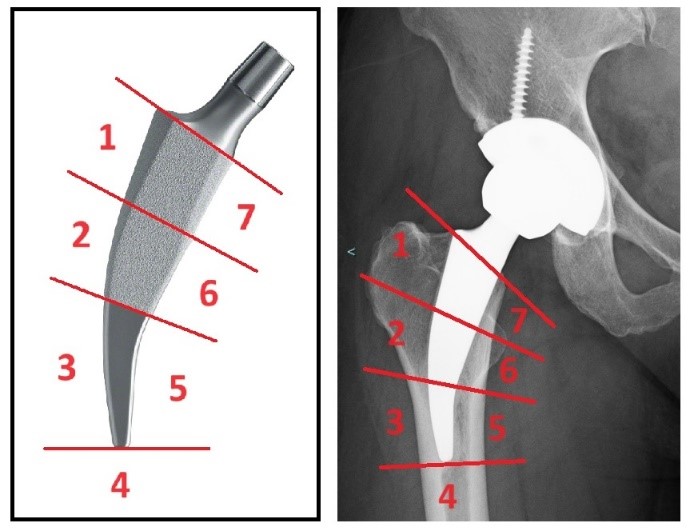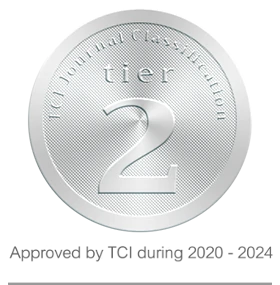Long-term Outcomes of Short-Stem Total Hip Arthroplasty in Patients Aged Forty Years or Younger with Osteonecrosis of the Femoral Head
DOI:
https://doi.org/10.56929/jseaortho-2025-0255Keywords:
short-stem, total hip arthroplasty, hip replacement, survival, osteonecrosisAbstract
Purpose: This study aimed to analyze the clinical and radiographic results with a minimum 10-year follow-up of short-stem total hip arthroplasty (THA) in patients aged 40 years or younger with osteonecrosis of the femoral head (ONFH).
Methods: A retrospective analysis was conducted on 45 of 55 eligible patients with ONFH who underwent Metha® short-stem THA, with a minimum 10-year follow-up (82% follow-up rate). The clinical outcomes were measured using the Harris Hip Score (HHS) and Forgotten Joint Score (FJS). Radiography was used to assess osteointegration, stem subsidence, and stress shielding. Patient satisfaction was recorded.
Results: The mean HHS significantly improved from 43.2 preoperatively to 97.4 at the final follow-up (p<0.0001), and the mean FJS score was 93.4. Radiography revealed osteointegration mainly in zones 1 (95.6%), 2 (88.9%), 6 (100%), and 7 (91.1%). The patient satisfaction was ‘very satisfied’ in 43 (95.6%) and ‘satisfied’ in 2 (4.4%) patients. The Kaplan-Meier survivorship for the overall implant system was 93.3% at 10 years, with revisions required in 3 cases (acetabular component or liner only). At 10 years, stem survivorship was 100% for any reason and 100% for aseptic loosening.
Conclusions: Short-stem THA provides promising long-term clinical outcomes for patients aged 40 years or younger with ONFH. Radiographic results demonstrated physiological proximal load transfer with minimal stress shielding.
Metrics
References
Gagala J, Tarczynska M, Gaweda K. A seven to 14-year follow-up study of bipolar hip arthroplasty in the treatment of osteonecrosis of the femoral head. Hip Int 2014;24:14-9. DOI: https://doi.org/10.5301/hipint.5000084
Nakasone S, Takao M, Sakai T, et al. Does the extent of osteonecrosis affect the survival of hip resurfacing? Clin Orthop Relat Res 2013;471:1926-34. DOI: https://doi.org/10.1007/s11999-013-2833-x
Bedard NA, Callaghan JJ, Liu SS, et al. Cementless THA for the treatment of osteonecrosis at 10-year follow-up: have we improved compared to cemented THA? J Arthroplasty 2013;28:1192-9. DOI: https://doi.org/10.1016/j.arth.2012.09.008
Swarup I, Shields M, Mayer EN, et al. Outcomes after total hip arthroplasty in young patients with osteonecrosis of the hip. Hip Int 2017;27:286-92. DOI: https://doi.org/10.5301/hipint.5000457
Kim YH, Kim JS, Park JW, et al. Contemporary total hip arthroplasty with and without cement in patients with osteonecrosis of the femoral head. A concise follow-up, at an average of seventeen years, of a previous report. J Bone Joint Surg Am 2011;93:1806-10. DOI: https://doi.org/10.2106/JBJS.J.01312
Kim YH, Oh JH, Oh SH. Cementless total hip arthroplasty in patients with osteonecrosis of the femoral head. Clin Orthop Relat Res 1995;(320):73-84. DOI: https://doi.org/10.1097/00003086-199511000-00013
Suksathien Y, Suarjui J, Ruangboon C, et al. Mid-term results of short versus conventional cementless femoral stems in patients with bilateral osteonecrosis of the femoral head. Eur J Orthop Surg Traumatol 2022;32:47-53. DOI: https://doi.org/10.1007/s00590-021-02924-2
Suksathien Y, Sueajui J. Mid-term results of short stem total hip arthroplasty in patients with osteonecrosis of the femoral head. Hip Int 2019;29:603-8. DOI: https://doi.org/10.1177/1120700018816011
Simank HG, Greiner R. Clinical and radiographic short to midterm results with the short hip stem prosthesis “Metha” in 120 cases. J Orthopaedics 2010;7:4-8.
Wittenberg RH, Steffen R, Windhagen H, et al. Five-year results of a cementless short-hip-stem prosthesis. Orthop Rev (Pavia) 2013;5:e4. DOI: https://doi.org/10.4081/or.2013.e4
Kamada S, Naito M, Nakamura Y, et al. Total hip arthroplasty using a short stem, stem design, position and size influence the development of bone trabeculae and appearance of radiolucent lines around the stem. Curr Orthop Pract 2011;22:52-8. DOI: https://doi.org/10.1097/BCO.0b013e3181f4b2bb
Ficat RP. Idiopathic bone necrosis of the femoral head. Early diagnosis and treatment. J Bone Joint Surg Br 1985;67:3-9. DOI: https://doi.org/10.1302/0301-620X.67B1.3155745
Dorr LD, Faugere MC, Mackel AM, et al. Structural and cellular assessment of bone quality of proximal femur. Bone 1993;14:231-42. DOI: https://doi.org/10.1016/8756-3282(93)90146-2
den Daas A, Reitsma EA, Knobben BAS, et al. Patient satisfaction in different approaches for total hip arthroplasty. Orthop Traumatol Surg Res 2019;105:1277-82. DOI: https://doi.org/10.1016/j.otsr.2019.08.003
Lerch M, von der Haar-Tran A, Windhagen H, et al. Bone remodelling around the Metha short stem in total hip arthroplasty: a prospective dual-energy X-ray absorptiometry study. Int Orthop 2012;36:533-8. DOI: https://doi.org/10.1007/s00264-011-1361-0
Engh CA, Bobyn JD, Glassman AH. Porous-coated hip replacement. The factors governing bone ingrowth, stress shielding, and clinical results. J Bone Joint Surg Br 1987;69:45-55. DOI: https://doi.org/10.1302/0301-620X.69B1.3818732
Suksathien Y, Chuvanichanon P, Tippimanchai T, et al. Insufficient lateral stem contact is an influencing factor for significant subsidence in cementless short stem total hip arthroplasty. World J Orthop 2022;13:444-53. DOI: https://doi.org/10.5312/wjo.v13.i5.444
Calder JD, Pearse MF, Revell PA. The extent of osteocyte death in the proximal femur of patients with osteonecrosis of the femoral head. J Bone Joint Surg Br 2001;83:419-22. DOI: https://doi.org/10.1302/0301-620X.83B3.0830419
Kim YH, Choi Y, Kim JS. Cementless total hip arthroplasty with ceramic-on-ceramic bearing in patients younger than 45 years with femoral-head osteonecrosis. Int Orthop 2010;34:1123-7. DOI: https://doi.org/10.1007/s00264-009-0878-y
Byun JW, Yoon TR, Park KS, et al. Third-generation ceramic-on-ceramic total hip arthroplasty in patients younger than 30 years with osteonecrosis of femoral head. J Arthroplasty 2012;27:1337-43. DOI: https://doi.org/10.1016/j.arth.2011.07.004
Johannson HR, Zywiel MG, Marker DR, et al. Osteonecrosis is not a predictor of poor outcomes in primary total hip arthroplasty: a systematic literature review. Int Orthop 2011;35:465-73. DOI: https://doi.org/10.1007/s00264-010-0979-7
Capone A, Bienati F, Torchia S, et al. Short stem total hip arthroplasty for osteonecrosis of the femoral head in patients 60 years or younger: a 3- to 10-year follow-up study. BMC Musculoskelet Disord 2017;18:301. DOI: https://doi.org/10.1186/s12891-017-1662-6
Kim YH, Park JW. Ultra-short anatomic uncemented femoral stem and ceramic-on-ceramic bearing in patients with idiopathic or ethanol-induced femoral head osteonecrosis. J Arthroplasty 2020;35:212-8. DOI: https://doi.org/10.1016/j.arth.2019.08.047
Floerkemeier T, Tscheuschner N, Calliess T, et al. Cementless short stem hip arthroplasty METHA® as an encouraging option in adults with osteonecrosis of the femoral head. Arch Orthop Trauma Surg 2012;132:1125-31. DOI: https://doi.org/10.1007/s00402-012-1524-5
Tippimanchai T, Suksathien Y, Suksathien R. Patient Reported Outcomes in Short Stem Total Hip Arthroplasty. JRCOST 2020;44:26-34.
Kim YH, Park JW. Long-term outcomes of ultra-short metaphyseal fitting anatomic cementless femoral stem in total hip arthroplasty with ceramic-on-ceramic articulation for young patients. J Arthroplasty 2019;34:2427-33. DOI: https://doi.org/10.1016/j.arth.2019.04.036
Schader JF, Thalmann C, Maier KS, et al. Prospective evaluation of clinical and radiographic 10-year results of Fitmore short-stem total hip arthroplasty. J Orthop Surg Res 2023;18:893. DOI: https://doi.org/10.1186/s13018-023-04359-3
Kim Y, Yoo JI, Kim HJ, Kim HY. Comparison of the mid-term results of metaphyseal-anchored short stem and conventional stem in total hip arthroplasty: A prospective cohort study. Orthop Traumatol Surg Res 2022;108:103304.
Kato S, Nozawa M, Kim S, et al. Comparison of the 5-year outcomes between standard and short fit-and-fill stems in Japanese populations. Arthroplasty Today 2022;15:108-14. DOI: https://doi.org/10.1016/j.artd.2022.03.023
Batailler C, Shatrov J, Schmidt A, et al. Similar stress repartition for a standard uncemented collared femoral stem versus a shortened collared femoral stem. SICOT J 2021;7:58. DOI: https://doi.org/10.1051/sicotj/2021061

Downloads
Published
How to Cite
Issue
Section
License
Copyright (c) 2025 The Royal College of Orthopaedic Surgeons of Thailand

This work is licensed under a Creative Commons Attribution-NonCommercial 4.0 International License.






